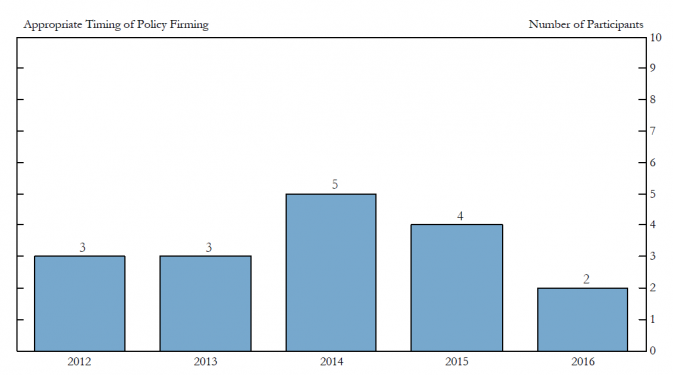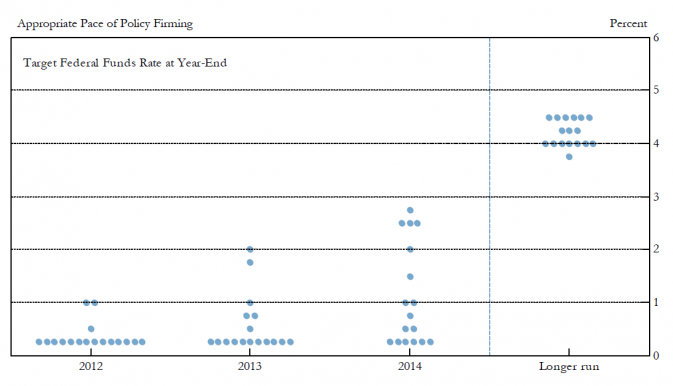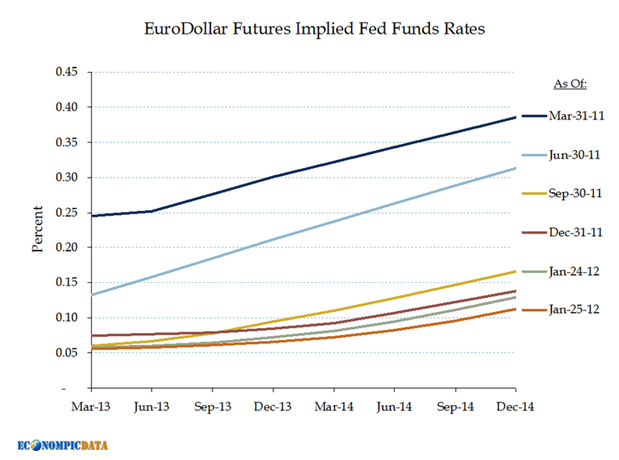“We never pre-commit” is the standard answer the ECB (European Central Bank) has for anyone asking about future interest rates (journalists regularly waste one of their two permitted questions at ECB press conferences).
Why should central bankers not indicate future interest rates decisions? Because market participants will price that information accordingly, so the announcement would have no or even a counter-intuitive effect on markets. This could potentially undermine the central bank’s credibility.
If central bankers want to keep their ability to influence asset prices, they need to keep markets guessing about future actions.
What on earth then is the Federal Reserve (“Fed”) doing?
The FOMC (Federal Open Market Committee) published where every member sees interest rates for the next three years and when they expected the first interest rate increase (see below):
What the heck?
This not only takes any element of surprise away; it also puts “outliers” under the spotlight and enhances groupthink (who wants to be the one that leaned out of the window and was completely wrong?).
Forget all the official statements. Forget anything you read in the “financial press”.
The Fed is printing money (“quantitative easing”) in order to achieve two goals:
1. Finance the government deficit
2. Cheapen the dollar (to help exports).
But how can you justify printing money when inflation is running at 3%, especially when you adopt an inflation target of 2%?
The Fed came up with a great plan: forecasting inflation of 1.6-2.0% for 2014 (at or below its new target) enables it to claim there is “danger of missing the target”. Hence printing more money is “required”.
In order to paint a picture of a weakening economy, the Fed starts out with elevated estimates for GDP growth, only to be able to reduce them at an opportune time.
The Fed now sees 2012 growth at 2.2-2.7%, down from 2.5-2.9% in its November forecast.
How Bernanke & Co. are able to predict inflation in 2014 when they couldn’t see a bursting housing bubble six months ahead is anybody’s guess.
The other benefit of forecasting (close to) zero percent interest rates into 2014 is the following: the Fed “sits” on the yield curve, depressing it as far out as possible by making markets price in available information. Euro Dollar futures have reacted and are now pricing in rates of less than 0.15% until the end of 2014:
This translates further into longer-dated bonds, depressing their yields. The Fed makes it easier for the government to pay its debt. If you pay zero interest on your debt (and assuming you can roll it over indefinitely) it has absolutely no effect on your budget. It is as if the debt didn’t exist (see How Dr. Ben Copperfield makes trillions disappear ).
All the pseudo-scientific yada-yada on economic theory are just hollow bones thrown to journalists and pundits to have something to “chew” on and write about.
The only thing that matters is the monetization of more and more government debt, and how to sell it to the public.
Paul Krugman would argue that despite all the “quantitative easing” inflation has not really picked up. At zero percent interest rates, money has no preference – there is no opportunity cost of just “lying around” without interest. Investing money for 4 years for 0.15% return is not “riskless return” – it’s “return-less risk”. Perversely, the Fed has created a situation where raising interest rates would probably lead to inflation. It is boxed into ZIRP (zero interest rate policy) for infinity.
Things will get serious once the Fed adopts a policy called N-GDP targeting. Instead of inflation, the Fed will try to “target” nominal GDP. If real GDP growth is zero, the nominal GDP growth will be made up entirely of inflation. Debt is a nominal unit, and it is supported by nominal GDP. In order to keep the ratio between GDP and debt halfway bearable, GDP must be inflated. It is a tax on everybody holding dollars, since the value of those will decline.
Meanwhile, the Japanese are resorting to stealth interventions to break the Yen’s strength. Currency wars have gone from “cold” to “hot”. The Fed’s printing of dollars is forcing other central banks to purchase them and selling their own currency in the hope of stemming their own currency’s rise. This makes them involuntary buyers of Treasury bills and bonds, making it easier for the US government to finance its deficit.
This, of course, will end badly. When the public loses confidence in paper currencies, barter trade and new, gold-backed currencies will be the only solution. “There is not enough gold” will the skeptics say, but it is only a question of price.



